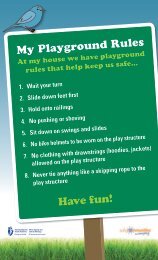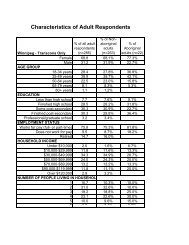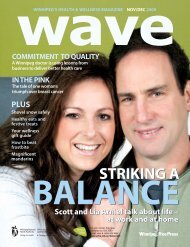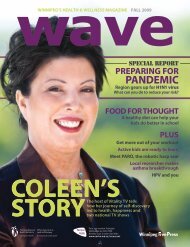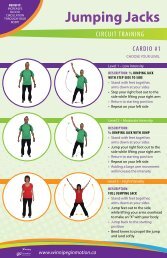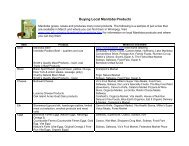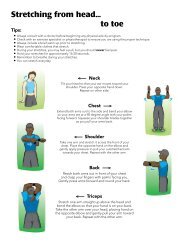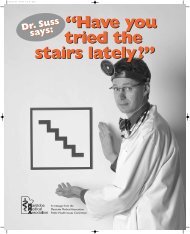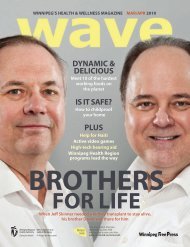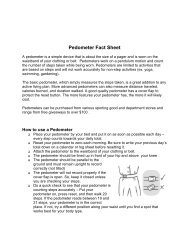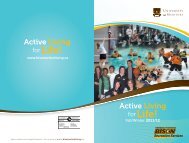Workplace Physical Activity Challenge - Winnipeg in motion
Workplace Physical Activity Challenge - Winnipeg in motion
Workplace Physical Activity Challenge - Winnipeg in motion
- No tags were found...
You also want an ePaper? Increase the reach of your titles
YUMPU automatically turns print PDFs into web optimized ePapers that Google loves.
ContentsReasons to be physically active 4Risks of <strong>in</strong>activity 5Five steps to a healthy heart 6<strong>Physical</strong> activity ideas for the workplace 8Walk<strong>in</strong>g 9Hot weather tips 9Cold weather tips 9Proper footwear checklist 10Safety tips 11Stretch<strong>in</strong>g 12Walk<strong>in</strong>g <strong>in</strong>tensity 12Goal sett<strong>in</strong>g 13Pedometers 14
S<strong>in</strong>ce Manitobans spend the majority of their time at work, it onlymakes sense to <strong>in</strong>corporate physical activity <strong>in</strong>to your daydur<strong>in</strong>g work hours. It doesn’t need to be difficult or timeconsum<strong>in</strong>g but mak<strong>in</strong>g small changes can have a number ofbenefits for your health.This booklet gives you tips and suggestions on how to<strong>in</strong>corporate physical activity <strong>in</strong>to your day at work as well assome general guidel<strong>in</strong>es for gett<strong>in</strong>g active. Keep this resourceavailable and use it as a rem<strong>in</strong>der to get mov<strong>in</strong>g.Reasons to be physically active:nPrevent illnesses like heart disease, stroke,type 2 diabetes, osteoporosis & some cancersnBe fit and strongnImprove flexibilitynHave fun and relaxnReduce stressnGet rid of angernFeel goodnFight boredomnManage weightnImprove movement skillsnBuild healthy bones, muscles and jo<strong>in</strong>tsnReduce depression and anxietynIncrease capacity for learn<strong>in</strong>gnIncrease self-esteemnHave energy4
Risks of <strong>in</strong>activityIncreased risk of:nHeart diseasenStrokenObesitynHigh blood pressurenDiabetesnOsteoporosisnColon cancerPeople who are physically <strong>in</strong>active have twice the risk for heartdisease and stroke. Active liv<strong>in</strong>g is important to ma<strong>in</strong>ta<strong>in</strong><strong>in</strong>g goodheart health throughout your life. Whether it’s garden<strong>in</strong>g, walk<strong>in</strong>gor runn<strong>in</strong>g, be<strong>in</strong>g active means someth<strong>in</strong>g different to everyone– but everyth<strong>in</strong>g counts.The <strong>Physical</strong> <strong>Activity</strong> Guide encourages 60 m<strong>in</strong>utes of mildactivity every day for health benefits, but you can start slowly andbuild up. You can add up 10-m<strong>in</strong>ute bouts of activitythroughout the day. As you progress to moderate activities, youcan cut down to 30 m<strong>in</strong>utes on four days a week. You should tryto progress to activities that <strong>in</strong>crease your heart rate to keep yourheart healthy.Choose a variety of activities that you enjoy and that fall <strong>in</strong>to thefollow<strong>in</strong>g categories:1. Endurance – 4 to 7 days a week of activities that arecont<strong>in</strong>uous and <strong>in</strong>crease your heart rate.2. Flexibility – 4 to 7 days a week of gentle reach<strong>in</strong>g, bend<strong>in</strong>gand stretch<strong>in</strong>g activities to keep your muscles relaxed andjo<strong>in</strong>ts mobile.3. Strength – 2 to 4 days a week of activities to strengthenmuscles and bones to improve posture.5
Five steps to a healthy heart1. Be smoke free - Smok<strong>in</strong>g, or exposure to second-handsmoke, is a major risk factor for cardiovascular disease. Nicot<strong>in</strong>e<strong>in</strong>jures the l<strong>in</strong><strong>in</strong>g of the arteries and <strong>in</strong>creases the build-up of fatdeposits <strong>in</strong> the area. This can lead to heart disease and/or stroke.It also makes the heart work harder and decreases the oxygencarried <strong>in</strong> the blood. Smok<strong>in</strong>g can double or triple the risk ofstroke.2. Eat a healthy diet - Eat<strong>in</strong>g a healthy diet is important tokeep your heart healthy. You can lower your risk of heart diseaseand stroke and implement a healthy diet by eat<strong>in</strong>g a varietyof foods, consum<strong>in</strong>g less fat, add<strong>in</strong>g more fiber <strong>in</strong>to your dietand remember<strong>in</strong>g to consume everyth<strong>in</strong>g <strong>in</strong> moderation. Toolsto help you make healthy food choices <strong>in</strong>clude Canada’s FoodGuide to Healthy Eat<strong>in</strong>g, and the Heart and Stroke Foundation’sHealth Check TM program.3. Know your blood pressure - High blood pressureis a modifiable risk factor that can be reduced through lifestylechanges. By ma<strong>in</strong>ta<strong>in</strong><strong>in</strong>g a healthy blood pressure you willdecrease your risk of heart disease and stroke.4. Get physically active - Regular physical activity isimportant for people of all ages and should be built <strong>in</strong>to a dailyrout<strong>in</strong>e. <strong>Physical</strong> activity helps you lead a heart healthy lifestyleand can help prevent aga<strong>in</strong>st many chronic diseases <strong>in</strong>clud<strong>in</strong>gheart disease and stroke.65. Take time to relax - Tak<strong>in</strong>g time for yourself andreduc<strong>in</strong>g your stress can help you decrease your risk of heartdisease and stroke. Some people turn to unhealthy practiceswhen under stress such as overeat<strong>in</strong>g, consum<strong>in</strong>g excessivealcohol, smok<strong>in</strong>g, etc. which leads to an unhealthy lifestyle. Itis important to recognize the signs of stress and learn how tomodify your life to reduce this stress.
<strong>Physical</strong> activity ideas for theworkplaceIncorporate some or all of the follow<strong>in</strong>g ideas to help keepyourself active dur<strong>in</strong>g your workday.nHave walk<strong>in</strong>g meet<strong>in</strong>gs.nExercise breaks – Incorporate short physical activity breaks<strong>in</strong>to the workday. Have a signal that rem<strong>in</strong>ds you to take anexercise break.nUse active modes of transportation like walk<strong>in</strong>g or cycl<strong>in</strong>g toget to and from work.nJo<strong>in</strong> a lunch time walk<strong>in</strong>g group.nGet off the bus a few stops early and walk the rest of the way.nPark farther away from your work site to get a few extra steps<strong>in</strong> before and after work.nLeave your lunch or someth<strong>in</strong>g else <strong>in</strong> the car so you have togo out and get it later.nTake the stairs <strong>in</strong>stead of elevators and escalators.nRoll your shoulders and stretch your neck while sitt<strong>in</strong>g <strong>in</strong> frontof a computer or at a desk.nUse a yoga ball to sit on at your desk, <strong>in</strong>stead of a chair, tohelp strengthen back and abdom<strong>in</strong>al muscles.nStart meet<strong>in</strong>gs with fun physically active warm ups like “simonsays” or musical chairs.nWalk to do errands or go to meet<strong>in</strong>gs <strong>in</strong>stead of driv<strong>in</strong>g.8
Walk<strong>in</strong>gWalk<strong>in</strong>g is one of the easiest ways to get active because itdoesn’t require expensive equipment, it can be enjoyed almostanywhere, by anyone, and is a natural movement that is virtually<strong>in</strong>jury free. Use the checklists below to ensure that you are safeand have fun.Hot Weather Tipsc Dr<strong>in</strong>k plenty of water before, dur<strong>in</strong>g and after walks.c If it is too hot, walk <strong>in</strong>doors <strong>in</strong> a temperature-controlledvenue or walk <strong>in</strong> the early morn<strong>in</strong>g or late even<strong>in</strong>g when itis cooler out.c Use sunscreen that is waterproof with a Sun ProtectionFactor (SPF) of 15 or more and sunglasses with UVProtection.c Wear a lightweight, light colored hat.c Choose light colored cloth<strong>in</strong>g to reflect the sun’s rays.Cold Weather Tipsc Dress <strong>in</strong> layers. You can always remove one of the layers ifyou get too hot.c Clothes should be warm and loose fitt<strong>in</strong>g to trap <strong>in</strong> heat.c Wear a breathable, waterproof w<strong>in</strong>d breaker as the toplayer to keep dry.c Wear a hat to hold <strong>in</strong> your body heat.c Dr<strong>in</strong>k plenty of water before, dur<strong>in</strong>g, and after your walk.c In extremely cold conditions cover exposed areas toprevent frostbite and use lip protector (like Chapstick)on your lips, nose, and ears.c Walk <strong>in</strong> a loop <strong>in</strong> case you need to cut your walk short.c Wear mittens, as they are warmer than gloves.c Shorten your stride to improve your foot<strong>in</strong>g.9
Proper Footwear Checklistc Choose leather shoes because leather breathes andmolds to your foot better.c Choose a well cushioned shoe to absorb the shock of theheel strike.c The soles should be strong and flexible with a good grip.c Shoes must be comfortable right away and do not requirea “break-<strong>in</strong>” period.c Good arch support is important.c The toe box should accommodate the toes comfortablywith room to wiggle.c The heel should fit snuggly and the <strong>in</strong>step should notgape open.c Shop for shoes later <strong>in</strong> the day when your feet are at theirlargest.c Try both shoes on and walk around to ensure they fitproperly.10
Safety Tipsc Don’t engage <strong>in</strong> vigorous physical activity if you are notfeel<strong>in</strong>g well and pay attention to your body’s signals. It isbetter to take a break than push too hard.c Allow time for your food to digest before a vigorousworkout.c Include a proper warm up and cool down.c Always walk on the sidewalk and if a sidewalk is notavailable walk on the left side of the road fac<strong>in</strong>g traffic.c Be visible and alert at all times. Wear reflective cloth<strong>in</strong>g ifwalk<strong>in</strong>g <strong>in</strong> the dark.c It is often beneficial to be active more frequently, ratherthan active at a higher <strong>in</strong>tensity.c Beg<strong>in</strong> your program slowly, as it will take time for yourbody to get used to a new level of activity.c Don’t be alarmed if you have some stiffness for the firstcouple of days. This will soon go away. If you are sore,try stretch<strong>in</strong>g your muscles.c If you cannot walk and talk without becom<strong>in</strong>g breathless,then slow down.c If walk<strong>in</strong>g alone, tell someone your route and expectedtime of return.c Run dur<strong>in</strong>g the day.c Carry identification with you and a quarter or cell phonefor an emergency phone call.11
Stretch<strong>in</strong>gYou should always try to stretch before and after be<strong>in</strong>g physicallyactive. Stretches should be done <strong>in</strong> a slow, controlled mannerand held for 15 to 30 seconds each. Make sure you cont<strong>in</strong>ue tobreathe dur<strong>in</strong>g your stretches. When perform<strong>in</strong>g stretches youshould feel a slight pull but never pa<strong>in</strong>.Walk<strong>in</strong>g IntensityHow fast you walk depends on your fitness level. Work atwhatever <strong>in</strong>tensity feels good to you, but make sure when youare first beg<strong>in</strong>n<strong>in</strong>g to start slowly. You can monitor your walk<strong>in</strong>g<strong>in</strong>tensity and gradually progress to a higher <strong>in</strong>tensity. It isimportant to listen to your body and you should never feel pa<strong>in</strong>.An easy way to measure whether you are walk<strong>in</strong>g too fast or notfast enough is by us<strong>in</strong>g a scale that measures your amount ofeffort. Ask yourself how hard you feel you are work<strong>in</strong>g andmatch it with this chart.12Amount of EffortDescription1 Rest<strong>in</strong>g You are breath<strong>in</strong>gnormally. It’s very easyto talk.23 Light You notice yourbreath<strong>in</strong>g. You can talk.45 Somewhat Hard You can hear yourselfbreathe, but can still talk.67 Hard You are breath<strong>in</strong>g heavily. Itis hard to talk.8910 Maximum You are breath<strong>in</strong>g veryheavily. You cannot talk.You may feel pa<strong>in</strong>.
Goal Sett<strong>in</strong>gResearch shows that <strong>in</strong>dividuals who set and monitor goals aremuch more likely to achieve them. Make sure you share yourgoals with others who can help support your efforts. Review yourgoals frequently and celebrate your success.The best way to achieve your goals is to set SMART goals.Specific Measurable Atta<strong>in</strong>able Realistic TimelyOutl<strong>in</strong>e<strong>in</strong> detailexactlywhat willbe doneand how.Decide howyou will assessyour progress.Make surethe goalsyou set arewith<strong>in</strong> yourreach.Your goalsshould bechalleng<strong>in</strong>gand fun butpossible foryou.Establish astart dateand enddate forachiev<strong>in</strong>gyour goal.Example:Walk threetimes aweek for30m<strong>in</strong>utes.Example:Record thedistance andtime of walkson thecalendar.Example:Walk for 10m<strong>in</strong>utes tostart andprogress to30 m<strong>in</strong>utes.Example:Walk<strong>in</strong>g isan easy andenjoyableactivity.Example:Startwalk<strong>in</strong>g <strong>in</strong>10 m<strong>in</strong>utesbouts; bythe end ofthe monthwill bewalk<strong>in</strong>gfor full 30m<strong>in</strong>utes.13
PedometersA great way to keep track of your progress and motivate yourselfis to use a pedometer.What is a pedometer?A pedometer is a simple device used to measure the number ofsteps you take.How do I wear a pedometer?Attach the pedometer to your belt or waistband near the front ofyour hipbone.How many steps should I take?Aim for 10,000 steps a day. If you have not been active, take abasel<strong>in</strong>e by count<strong>in</strong>g your steps on the first day and then aim to<strong>in</strong>crease that by 10% per week. If you are already active, you canset your goal to <strong>in</strong>crease your steps to even higher levels. Anextra 5,000 steps is roughly equivalent to 4 KM.Can I count other activities?If you want to use the step goal dur<strong>in</strong>g other activities for whichyou cannot wear a pedometer, use the chart on the next page tohelp.Multiply the number of m<strong>in</strong>utes <strong>in</strong> which you engage <strong>in</strong> theactivity times the equivalent steps per m<strong>in</strong>ute as <strong>in</strong>dicated <strong>in</strong> thechart.14
Steps per m<strong>in</strong>ute <strong>Activity</strong>42 Weight lif<strong>in</strong>g (arms only)49 Swimm<strong>in</strong>g (tread<strong>in</strong>g water)49 Canoe<strong>in</strong>g (leisurely)51 Mopp<strong>in</strong>g floors51 Cycl<strong>in</strong>g (5.5 mph)64 Weight lift<strong>in</strong>g (abdom<strong>in</strong>als)73 Garden<strong>in</strong>g, weed<strong>in</strong>g78 Pa<strong>in</strong>t<strong>in</strong>g outside (house, fence)84 Ice skat<strong>in</strong>g (leisurely)89 Stack<strong>in</strong>g firewood89 Swimm<strong>in</strong>g (breast stroke, 1 mph)90 Stair climb<strong>in</strong>g (26 stairs/m<strong>in</strong>ute)93 Cycl<strong>in</strong>g (10 mph)93 Danc<strong>in</strong>g (socially)98 Badm<strong>in</strong>ton (play<strong>in</strong>g competitively)102 Tennis (competitive doubles)102 Horseback rid<strong>in</strong>g (trott<strong>in</strong>g)104 Water ski<strong>in</strong>g109 Ski<strong>in</strong>g (downhill, slowly)114 Ski<strong>in</strong>g (cross country, slowly)129 Basketball (recreational play)131 Box<strong>in</strong>g (non-competitive)138 Racquetball (recreational play)142 Handball (recreational play)144 Soccer (recreational play)147 Row<strong>in</strong>g (3.5 mph)153 Mounta<strong>in</strong> climb<strong>in</strong>g160 Cycl<strong>in</strong>g (rac<strong>in</strong>g competitively)184 Runn<strong>in</strong>g (9-m<strong>in</strong>ute mile)220 Football (play<strong>in</strong>g competitively)15
Heart and Stroke Foundation of Manitoba6 Donald Street<strong>W<strong>in</strong>nipeg</strong>, MB R3L 0K6In <strong>W<strong>in</strong>nipeg</strong>: 949.2000In Brandon: 571.4080Toll-free: 1.888.473.4636Email: ask@heartandstroke.mb.caWeb: heartandstroke.mb.ca



